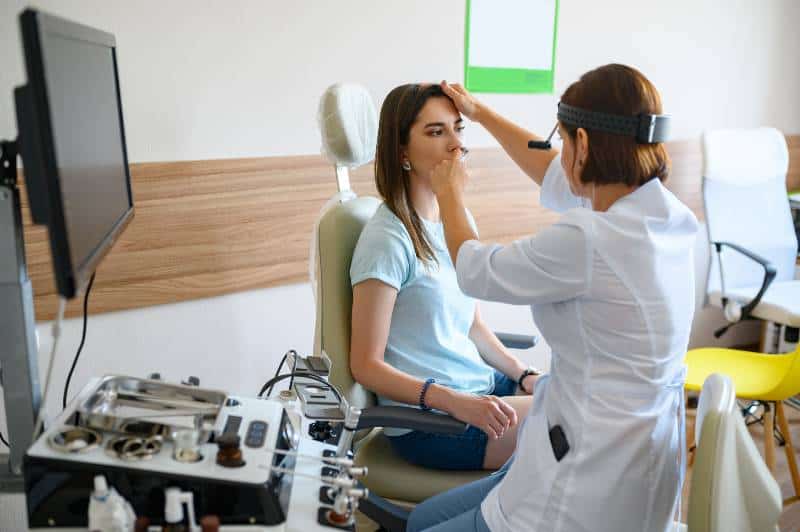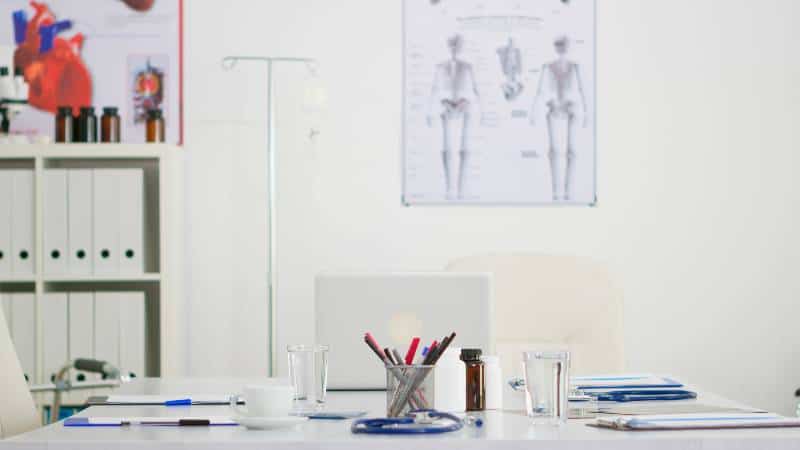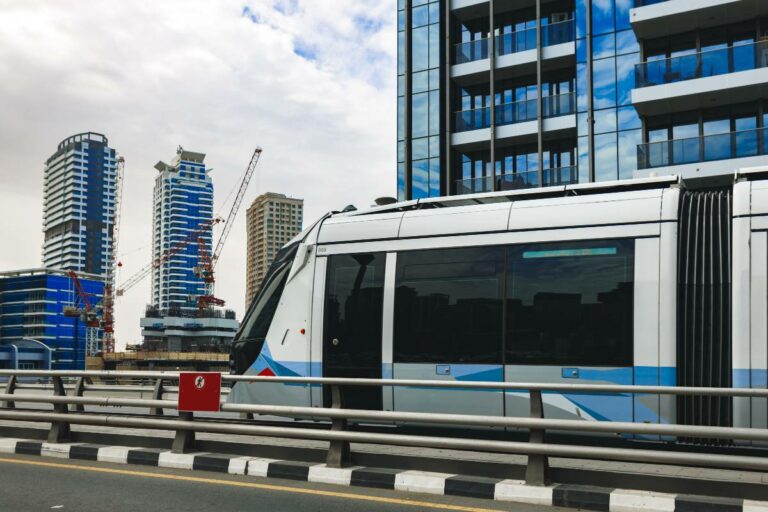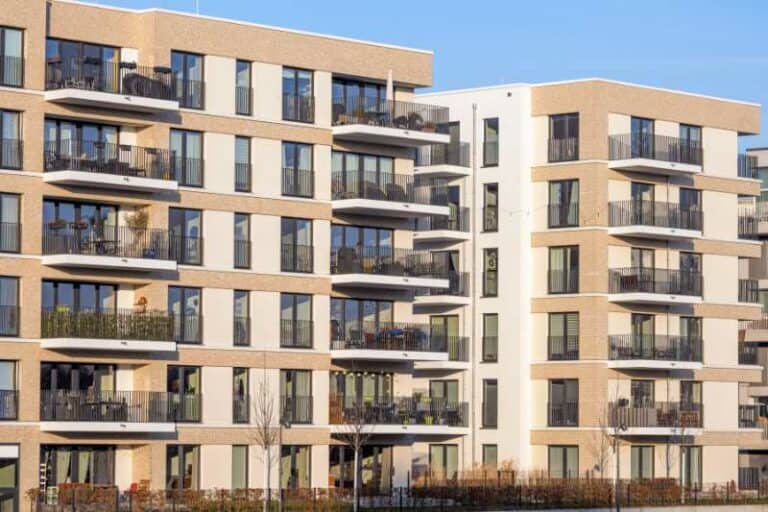Prepare to step into the future of healthcare! From influencing patient outcomes to changing clinical operations and workflow – medical office building design is a key factor in advancing medicine. In this blog post we will explore revolutionary trends that are revolutionizing medical offices for healthier futures everywhere. Let’s discover how smart designs can lead us closer to improved care delivery and remarkable patient experiences.
To provide the safest possible experience and keep everyone healthy, medical office buildings are evaluating innovative solutions such as virtual consultations. This way patients can receive essential care without having to be physically present in an office setting.
Key Takeaways
- Medical offices are embracing cutting-edge designs to provide the best possible care for their patients.
- A combination of smarter layouts, modern equipment, and improved spaces is helping these facilities revolutionize healthcare around the world; allowing staff and patients alike to benefit from more efficient processes enabled by technological advancement.
- By investing in smart medical office design, better patient health outcomes can be achieved with increased satisfaction all around.

Today’s medical space is undergoing a transformation, revolutionizing the way hospitals and clinics are designed. From incorporating cutting-edge technology to achieving an optimal balance between comfort and security for patients, it is clear that modern designs have much more to offer than their predecessors.
In this article, we will explore how industry professionals can best utilize these tools of innovation in order to create functional office environments which promote efficiency while providing excellent care. We’ll also discuss ways architects must plan ahead when creating robust infrastructures; scalable systems capable of withstanding fluctuating demand – as well as future academic pursuits by uncovering what constitutes the ideal medical office setup today.
Current Trends in Medical Office Design and Functionality
Emphasis on patient experience and satisfaction
To create the ideal medical office experience for patients, practices are making thoughtful design decisions – from color choices and artwork on walls to strategically placed seating. These features combine with staff members selected for their professional yet friendly demeanor to convey an atmosphere of comfort in which those seeking treatment can feel welcome and in good hands. Investing both time and resources into designing a patient-friendly environment is essential; doing so will ensure that your practice stands out while also demonstrating care toward its visitors.
Use of technology to enhance efficiency and communication
Medical office design has advanced significantly over the past few years, allowing for a greater degree of efficiency and customer service. Innovative digital patient portals offer flexible scheduling tools while mobile applications support efficient record-keeping. In addition, cutting-edge medical systems built into building infrastructure can help streamline routine tasks, as well as provide key insights such as foot traffic volume analytics to ensure patients are always provided with top professional care.
Integration of wellness and sustainability concepts
Today’s healthcare facilities are undergoing a much-needed revolution, with more focus being placed on creating spaces that promote well-being and sustainability. By introducing minimalist designs to medical office settings, calming atmospheres can be fostered which leads not only to increased patient comfort but also improved outcomes as studies have shown.
Investing in healthful environments is now seen as an integral part to promote the healing process.
Medical facilities today are transforming to create an even better experience for both patients and staff members. Business leaders are recognizing that going green, having luxury vinyl floors, improved air quality, natural lighting strategies, and patient satisfaction levels can help maximize their success.
Not only does this make financial sense, but the comfort and relaxation achieved through these renovations also bring an extra level of luxury to medical facilities. With each investment in creating a spa-like atmosphere, medical practices are also investing in their reputation, as well as giving people something to look forward to when they go for what can often be unpleasant appointments or treatments.
Shift towards multidisciplinary and team-based care models
Healthcare organizations are now leveraging innovative office designs and functionalities to ensure better patient care. By promoting a multidisciplinary, team-based approach with improved communication flows between departments and collaborative spaces, providers can deliver high-quality treatments while providing greater value for patients’ needs.
Through clever utilization of technology, exceptional guest experiences can be crafted.
Real-time tracking and minimized wait times ensure that service is as smooth and efficient as possible; while intelligent medical facilities enable seamless processes to elevate patient engagement throughout the care journey – resulting in increased customer satisfaction.
In times like this when more people than ever before are seeking medical help, it is essential for healthcare businesses and organizations to focus on modern trends that bear a friendly yet professional tone.
Future Trends in Medical Office Design and Functionality
Virtual and telemedicine advancements
Telemedicine, right? It’s this game-changer that lets doctors and patients catch up over video calls or phone chats, making sure everyone stays connected without having to be in the same room. Think about it like FaceTiming your doc instead of sitting in a waiting room flipping through old magazines.
When COVID hit, it was like the whole world suddenly figured out how handy these video visits could be. It’s not just about staying safe; it’s also super convenient. You can chat with your doctor while chilling on your couch, without worrying about traffic or taking time off work.
But it’s not just about the chats. Virtual care is this whole world where you can monitor your health from home. Imagine wearing a gadget that keeps an eye on your heartbeat or blood sugar and sends the info straight to your doctor. It’s like having a mini-doc with you all the time, making sure everything’s ticking along just right.
And this isn’t just great news for folks living in the big city. It’s a game-changer for people in rural spots where it’s tougher to get to a specialist. With virtual care, everyone’s got a front-row seat to top-notch healthcare, no matter where they live.
Now, what does all this mean for medical office design? Well, we’re talking about spaces that need to be tech-savvy, with spots set up for docs to do their virtual consults without skipping a beat. And since not everything can be done remotely, we still need those real-life exam rooms designed smartly to make every visit as smooth as possible.
So, as we peek into the future of medical offices, it’s all about blending the best of both worlds – the hands-on care we’re used to and the super cool virtual stuff that’s changing the game. It’s an exciting time, and who knows what’s next? But one thing’s for sure, the future of healthcare is looking pretty bright.
Uncover the future of medical care by diving into this article – get an inside look at how telemedicine is revolutionizing healthcare and providing people with access to life-saving treatments no matter where they are.
Increased focus on infection prevention and control
As we increase our knowledge of how to best mitigate the potential for infection spread within medical settings, it’s clear that office design and functionality must be tailored accordingly.
Furniture construction, air/surface filtration systems, touchless technology installation, and HVAC system optimization for improved ventilation – all are critical components in creating a safe space where patients can feel confident they’re receiving quality care without incident or threat of contagion transmission.
By incorporating these measures into their setup plans with few key modifications on top of daily safety protocols, leading-edge medical offices will remain at the forefront when it comes to infection control procedures standards.
Emphasis on patient privacy and confidentiality
Medical offices are starting to realize the importance of designing their spaces with patient privacy and confidentiality in mind. Elements such as strategically placed reception desks, shielded walls, and sound-attenuating materials will soon become more commonplace features in medical office design.
For medical staff, these types of solutions can offer assurance that their patients’ private and confidential information is held to the highest standard of security. With a greater focus on patient privacy, medical office designs are creating welcoming and comfortable environments for both staff and patients alike.
These shifts in medical office design trends recognize the significance of patient trust at a time when many individuals are increasingly conscious about the safety of their data. As such, it is encouraging that the healthcare industry has embraced the need for patient-first design—allowing for better experiences for those accessing critical medical services.
Integration of artificial intelligence and machine learning
Unlike humans, AI never needs to sleep. It may be possible to employ machine learning models to monitor the vital signs of patients who are undergoing critical care and to provide an alarm to physicians if specific risk indicators grow. While some medical equipment, such as heart monitors, are able to monitor vital signs, AI is able to aggregate the data that is produced by those devices and search for more complex illnesses, such as sepsis.
One of IBM’s customers has created a predictive artificial intelligence model for premature neonates that is 75% accurate in diagnosing serious sepsis.
Also, With the use of artificial intelligence (AI), precision medicine might become easier to support. AI has the potential to provide patients with tailored real-time recommendations around the clock. This is made possible by the AI model’s ability to learn and remember patients’ preferences. A patient would not have to repeat information with a new person each time if a healthcare system provided them with round-the-clock access to an AI-powered virtual assistant.
This assistant would be able to answer questions based on the patient’s medical history, preferences, and personal needs. This would eliminate the need for the patient to repeat information.
Use of data analytics for improving patient outcomes and staff productivity
Data analytics is revolutionizing clinical settings by empowering healthcare providers to better serve their patients. By leveraging population health data for predictive purposes, wait times are being drastically reduced and more appointment options are becoming available—ultimately leading to lower readmission rates! Physicians now have the tools they need to provide quality patient care in a cost-effective manner.
The Impact of COVID-19 on Medical Office Design and Functionality
Changes in physical layout and design to accommodate social distancing guidelines
The coronavirus pandemic has significantly impacted medical offices, requiring thoughtful redesigns to ensure safety. This includes introducing social distance practices such as limiting the capacity of space and rearranging furniture accordingly; adding single-occupancy restrooms where possible; upgrading ventilation systems with new exhaust fans and increased filtration requirements; using physical or visual dividers in a waiting room, exam rooms, doctor’s office, and even in private rooms for extra protection between patients; and implementing frequent disinfection protocols on surfaces plus touchless technology options wherever applicable.
Use of personal protective equipment (PPE) and disinfection protocols
As the healthcare industry continues to grapple with the challenges posed by COVID-19, medical office designs have had to adapt in order for patients and staff alike to feel safe. To that end, uniforms of personal protective equipment (PPE), physically distanced and spa-like waiting rooms, designated outdoor lines for those awaiting care or checkups as well as disinfection protocols between uses are now commonplace when entering most medical facilities.
Although a lot has changed from how it may have been pre-pandemic times, one thing remains: patient safety is still paramount but so too is creating an atmosphere where friendly faces behind masks make them feel at ease during what can be stressful visits.
Increased utilization of telemedicine and virtual consultations
With countries across the globe facing uncertain times during the COVID-19 pandemic, medical offices have had to make a number of adjustments in order to embrace social distancing and ensure safe operations. It has become increasingly necessary for telemedicine and virtual consultations to be utilized more than ever before which limits unnecessary journeys while still providing essential primary care and also preventative care. Furthermore, redesigning reception areas is vital so that both healthcare workers and patients can practice physical separation as much as possible whilst considering other important aspects such as supply chain continuity, employee safety, and workplace layout.
Challenges and Considerations for Future Medical Office Design and Functionality
Balancing patient comfort and safety with staff efficiency and productivity
As safety protocols and patient expectations evolve in the post-pandemic world, medical office spaces must innovate their medical office interior design and functionality to maintain a safe but comfortable environment. This could involve implementing better noise-dampening design features, insulation or physical partitions between patients, versatile workspaces that also support digital functions, technological solutions which reduce contact time with providers, automated cleaning systems for infection risk reduction as well as additional PPE where applicable. Crafting an effective medical office space should ultimately ensure patient comfort while simultaneously improving staff efficiency and productivity.
Ensuring accessibility and inclusivity for all patients
Designing a medical office isn’t just about functional medical office layout–it’s also essential to craft an atmosphere that makes all types of patients feel welcome and safe. To do this, consider the variety of needs your patient population may have by incorporating accessible ramps or wider doorways for those with mobility restrictions.
Adding elements like natural light, calming colors, and intuitive technology (like interactive portals) throughout the space can not only heighten privacy but reduce any anxieties or discomfort associated with visiting a healthcare facility. Investing in practical amenities as well as focusing on creating and reducing stress, a nice ambiance will undoubtedly deliver greater convenience while allowing staff members to better help their guests without compromising comfort levels!
Addressing the needs of different medical specialties and sub-specialties
It’s more important than ever for medical offices to create a secure and welcoming atmosphere that accommodates all patients, no matter their age, gender identity, ethnicity, or ability level. Through thoughtful medical clinic design which takes into account accessibility and removes physical barriers wherever possible – alongside meaningful engagement with communities around issues of inclusivity – healthcare providers can help promote diversity both within the office setting as well as related organizations. By authentically addressing these essential elements of healthcare equality we’re empowering environments where everyone feels safe enough to receive quality services.
Adapting to changing regulatory and legal requirements
Keeping a medical office running efficiently and compliantly is no small feat. From designers to contractors, it’s important that all involved understand the modern advances in both the design process and function for legal compliance.
Not only must the aesthetic provide an inviting environment, but practicalities such as energy efficiency or blueprints have to be considered when constructing new offices or renovating existing ones – making sure safety regulations are met every step of the way!
Communication between stakeholders is essential during this process in order to deliver clear expectations on how they can work together toward creating a successful practice while also providing cost-effective solutions.
The Future of Medical Office Design And Functionality FAQs
What is the current focus of medical office design and functionality?
Medical office design and functionality is constantly evolving, allowing healthcare professionals to provide better patient care in a more efficient manner. From strategically placed telehealth systems to optimized workflows – medical offices are transforming every day to support the modern practice of medicine.
How are medical offices using technology to improve patient care and staff productivity?
Medical offices are leveraging technology to enhance the patient experience and elevate staff efficiency. With technical advancements, medical professionals can do more in less time while providing care that is tailored to each individual’s needs.
How will virtual and telemedicine advancements impact the design and functionality of medical offices?
With the increasing prevalence of virtual and telemedicine solutions, medical offices are being reinvented to deliver better care. We’ll explore how advances in tech have reshaped healthcare delivery from both an operational and design perspective!
What are the challenges of designing medical offices that are accessible and inclusive to all patients?
Designing medical offices to be inclusive of patients from all walks of life presents an array of challenges. From ensuring everyone has easy access and feel welcomed, it is essential for office designs to strike the perfect balance between practicality and inviting warmth.
How are medical offices integrating AI and machine learning into their design and functionality?
From electronic medical records to chatbots, AI and machine learning are revolutionizing the way that medical offices operate. By incorporating these cutting-edge technologies into their design and functionality, healthcare providers can create a more efficient space for providing essential services to patients.
Conclusion
It’s clear that medical office design and functionality play a big role in providing quality patient care. As we look to the future, it will be important to continue to evolve our designs to meet the changing needs of patients and staff. We’re excited about the potential for virtual and telemedicine advancements and believe they hold great promise for improving patient care.
The COVID-19 pandemic has brought many challenges, but it has also given us an opportunity to re-evaluate our physical layouts and make changes that will help keep everyone safe. If you’re thinking about making changes to your medical office, I’d love to help. Schedule a free consultation today so we can discuss your specific needs!
Blog Articles Disclaimer
The information presented in articles on our website or affiliated platforms is exclusively intended for informational purposes. It’s crucial to grasp that this content does not constitute professional advice or services. We strongly recommend our readers to seek guidance from appropriately qualified experts, including, but not limited to, real estate and other attorneys, accountants, financial planners, bankers, mortgage professionals, architects, government officials, engineers, and related professionals. These experts can offer personalized counsel tailored to the specific nuances of your individual circumstances. Relying on the content without consulting the relevant experts may hinder informed decision-making. Consequently, neither Tolj Commercial Real Estate nor its agents assume any responsibility for potential consequences that may arise from such action.






